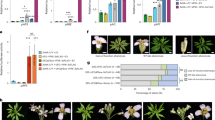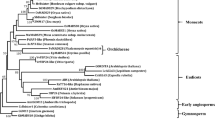Abstract
Abscission is a universal and dynamic process in plants whereby organssuch as leaves, flowers and fruit are shed, both during normal development,and in response to tissue damage and stress1. Shedding occursby separation of cells in anatomically distinct regions of the plant, calledabscission zones (AZs). During abscission, the plant hormone ethylene stimulatescells to produce enzymes that degrade the middle lamella between cells inthe AZ. The physiology and regulation of abscission at fully developed AZsis well known2,3, but the molecular biology underlying theirdevelopment is not. Here we report the first isolation of a gene directlyinvolved in the development of a functional plant AZ. Tomato plants with the jointless mutation4 fail to develop AZs on their pedicelsand so abscission of flowers or fruit does not occur normally. We identify JOINTLESS as a new MADS-box gene in a distinct phylogenetic clade separatefrom those functioning in floral organs. We propose that a deletion in JOINTLESS accounts for the failure of activation of pedicel AZ developmentin jointless tomato plants.
This is a preview of subscription content, access via your institution
Access options
Subscribe to this journal
Receive 51 print issues and online access
$199.00 per year
only $3.90 per issue
Buy this article
- Purchase on Springer Link
- Instant access to full article PDF
Prices may be subject to local taxes which are calculated during checkout




Similar content being viewed by others
References
Bleecker, A. B. & Patterson, S. E. Last exit:senescence, abscission, and meristem arrest in Arabidopsis. Plant Cell 8, 1169–1179 (1997).
Addicott, F. T. Abscission (Univ. of California Press, Berkeley, Los Angeles, London, 1982).
Jinn, T. L., Stone, J. M. & Walker, J. C. HAESA, an Arabidopsis leucine-richrepeat receptor kinase, controls floral organ abscission. GenesDev. 14, 108–117 (2000).
Butler, L. Inherited characters in the tomato. II. Jointless pedicel. J. Hered. 37, 25–26 (1936).
Roberts, J. A., Schindler, C. B. & Tucker, G. A. Ethylene-promoted tomato flower abscission and thepossible involvement of an inhibitor. Planta 160, 159–163 (1984).
Rick, C. M. & Sawant, A. C. Factor interactions affectingthe phenotypic expression of the jointless character in tomatoes. Am. Soc. Hort. Sci. 66, 354–360(1955).
Pnueli, L. etal. The SELF-PRUNING gene of tomato regulates vegetative toreproductive switching of sympodial meristems and is the ortholog of CEN andTFL1. Development 125, 1979–1989 (1998).
Szymkowiak, E. J. & Irish, E. E. Interactionsbetween jointless and wild-type tomato tissues during development ofthe pedicel abscission zone and the inflorescence meristem. PlantCell 11, 159–175 (1999).
Rick, C. M. & Yoder, J. I. Classical and molecular geneticsof tomato: highlights and perspectives. Annu. Rev. Genet. 22, 281–300 (1988).
Wing, R. A., Zhang, H. B. & Tanksley, S. D. Map-based cloning in crop plants. Tomato as a model:I. Genetic and physical mapping of jointless. Mol.Gen. Genet. 242, 681–688 (1994).
Zhang, H. -B., Martin, G. B., Tanksley, S. D. & Wing, R. A. Map-based cloning in crop plants. Tomato as a model system II. Isolation andcharacterization of a set of overlapping yeast artificial chromosomes encompassing jointless locus. Mol. Gen. Genet. 244, 613–621 (1994).
Budiman, M. A., Mao, L., Wood, T. & Wing, R. A. A deep-coveragetomato BAC library and prospects toward development of an STC framework forgenome sequencing. Genome Res. 10, 129–136 (2000).
Yanofsky, M. F. et al. The protein encoded by the Arabidopsis homeotic gene agamous resembles transcription factors. Nature 346, 35–39 (1990).
Sommer, H. et al. Deficiens, a homeotic gene involved in the controlof flower morphogenesis in Antirrhinum majus: the protein shows homologyto transcription factors. EMBO J. 9, 605–613 (1990).
Riechmann, J. L. & Meyerowitz, E. M. MADS domainproteins in plant development. Biol. Chem. 378, 1079–1101 (1997).
Carmona, M. J., Ortega, N. & Garcia-Maroto, F. Isolation and molecular characterization of a new vegetativeMADS-box gene from Solanum tuberosum L. Planta 207, 181–188 (1998).
Anthony, R. G., James, P. E. & Jordan, B. R. The cDNA sequence of a cauliflower apetala-1/squamosa homolog. Plant Physiol. 108, 441–442 (1995).
Kang, H. G., Jang, S., Chung, J. E., Cho, Y. G. & An, G. Characterization of two rice MADS box genes that control flowering time. Mol. Cell 7, 559–566 (1997).
Pnueli, L., Hareven, D., Rounsley, S.D., Yanofsky, M. F. & Lifschitz, E. Isolation of the tomato AGAMOUS gene TAG1 and analysis of its homeotic role in transgenic plants. Plant Cell 6, 163–173 (1994).
Pnueli, L. et al. The MADS box gene family in tomato: temporal expression duringfloral development, conserved secondary structures and homology with homeoticgenes from Antirrhinum and Arabidopsis. Plant J. 1, 255–266 (1991).
Gu, Q., Ferrandiz, C., Yanofsky, M. F. & Martienssen, R. The FRUITFULL MADS-box gene mediates cell differentiation during Arabidopsis fruit development. Development 125, 509–1517 (1998).
Liljegren, S. J. et al. SHATTERPROOF MADS-box genes control seed dispersalin Arabidopsis. Nature 404, 766–770 (2000).
Petersen, M. et al. Isolation and characterisation of a pod dehiscence zone-specificpolygalacturonase from Brassica napus. Plant Mol. Biol. 31, 517–527 (1996).
Altschul, S. F. et al. Gapped BLAST and PSI-BLAST: a new generation of protein databasesearch programs. Nucleic Acids Res. 25, 3389–3402 (1997).
Bernatzky, R. & Tanksley, S. D. Methods for detection of singleor low copy sequences in tomato on Southern blots. Plant Mol. Bio.Rep. 4, 37–41 (1986).
McCormick, S. et al. Leaf disc transformation of cultivated tomato (L. esculentum) using Agrobacterium tumefaciens. Plant Cell Reporters 5, 81–84 (1986).
Acknowledgements
We thank H.-B. Zhang, S. D. Choi and C. Scheuring for their work duringthe early stage of this project; C. M. Rick for the NILs LA3023 and LA3021;S. S. Woo for sequence analysis of YAC end TY159L; and the staff of the CUGIDNA Sequencing, Bioinformatics (M. Sasinowsky) and BAC/EST Resource (D. Frisch)Centers. This work is supported by a National Science Foundation grant toR.A.W and E.J.S and the Coker Chair in Plant Molecular Genetics to R.A.W.Any opinions, findings, and conclusions or recommendations expressed in thismaterial are those of the author(s) and do not necessarily reflect the viewsof the National Science Foundation.
Author information
Authors and Affiliations
Corresponding author
Rights and permissions
About this article
Cite this article
Mao, L., Begum, D., Chuang, Hw. et al. JOINTLESS is a MADS-box gene controlling tomato flower abscissionzone development. Nature 406, 910–913 (2000). https://doi.org/10.1038/35022611
Received:
Accepted:
Issue Date:
DOI: https://doi.org/10.1038/35022611
This article is cited by
-
Influence of the Cellular Ultrastructure and Enzyme Activity of the Leaf Sheath on Spontaneous Defoliation in Sugarcane
Tropical Plant Biology (2024)
-
Multiplex CRISPR-Cas9 knockout of EIL3, EIL4, and EIN2L advances soybean flowering time and pod set
BMC Plant Biology (2023)
-
The rose INFLORESCENCE DEFICIENT IN ABSCISSION-LIKE genes, RbIDL1 and RbIDL4, regulate abscission in an ethylene-responsive manner
Plant Cell Reports (2023)
-
Functions of the E-class Floral Homeotic Genes in Several Common Dicotyledons
Journal of Plant Growth Regulation (2022)
-
Multi-scale comparative transcriptome analysis reveals key genes and metabolic reprogramming processes associated with oil palm fruit abscission
BMC Plant Biology (2021)
Comments
By submitting a comment you agree to abide by our Terms and Community Guidelines. If you find something abusive or that does not comply with our terms or guidelines please flag it as inappropriate.



